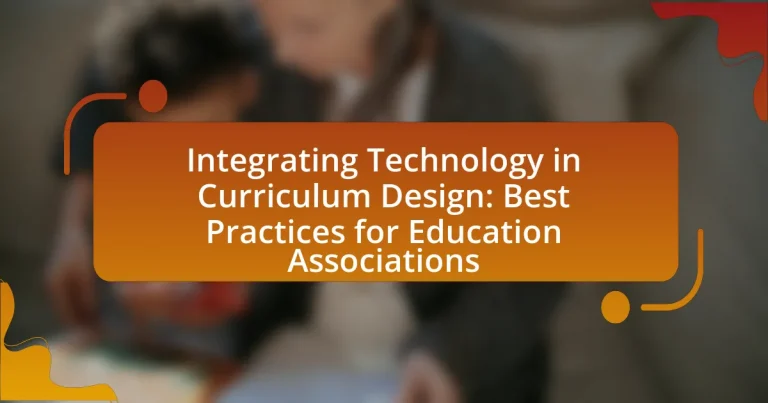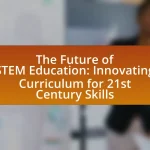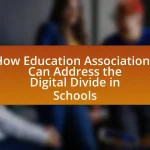Integrating technology in curriculum design involves the systematic incorporation of digital tools and resources to enhance educational experiences and improve student outcomes. This article outlines how technology enhances curriculum design through personalized learning, accessibility, and collaboration, while also identifying key technologies such as Learning Management Systems and multimedia tools. It discusses the importance of technology integration for education associations, the challenges faced without it, and best practices for successful implementation. Additionally, the article highlights the role of collaboration, partnerships, and ongoing training in fostering effective technology use, as well as potential pitfalls and metrics for evaluating success in educational settings.
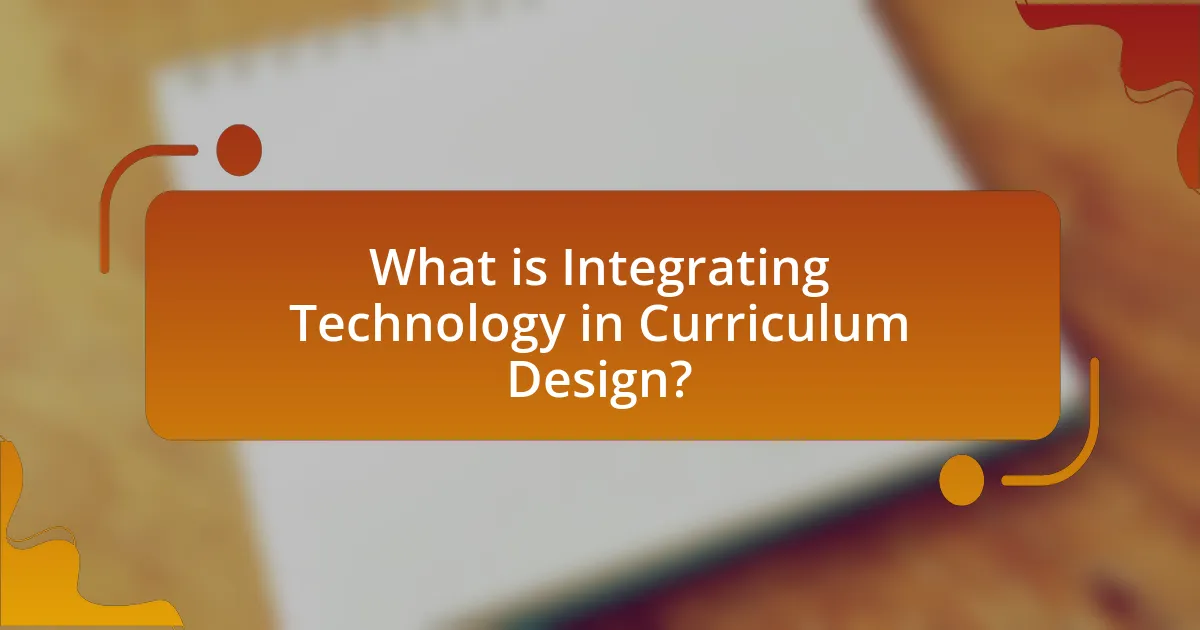
What is Integrating Technology in Curriculum Design?
Integrating technology in curriculum design refers to the systematic incorporation of digital tools and resources into educational frameworks to enhance teaching and learning experiences. This approach aims to create a more interactive and engaging environment, facilitating personalized learning and improving student outcomes. Research indicates that technology integration can lead to increased student motivation and achievement, as evidenced by a study published in the Journal of Educational Technology & Society, which found that students using technology in their learning processes showed higher engagement levels and better academic performance.
How does technology enhance curriculum design?
Technology enhances curriculum design by facilitating personalized learning experiences and improving accessibility. Through adaptive learning platforms, educators can tailor content to meet individual student needs, allowing for differentiated instruction that accommodates various learning styles. Research indicates that technology integration in education leads to increased student engagement and achievement; for instance, a study by the Bill & Melinda Gates Foundation found that personalized learning approaches can significantly boost student performance in mathematics and reading. Additionally, technology provides tools for collaboration and communication, enabling students to work together effectively, regardless of their physical location. This interconnectedness fosters a more inclusive learning environment, ensuring that diverse learners can access quality educational resources.
What are the key technologies used in curriculum design?
Key technologies used in curriculum design include Learning Management Systems (LMS), multimedia tools, and data analytics platforms. Learning Management Systems, such as Moodle and Canvas, facilitate the organization and delivery of educational content, enabling educators to track student progress and engagement. Multimedia tools, including video editing software and interactive presentation platforms, enhance the learning experience by providing diverse content formats that cater to different learning styles. Data analytics platforms, like Tableau and Google Analytics, allow educators to analyze student performance data, informing curriculum adjustments and improving educational outcomes. These technologies collectively support effective curriculum design by promoting engagement, personalization, and data-driven decision-making.
How do these technologies improve student engagement?
Technologies improve student engagement by facilitating interactive learning experiences that capture students’ attention and foster participation. For instance, tools like gamified learning platforms and virtual simulations create immersive environments where students can actively participate in their education. Research shows that gamification can increase student motivation and engagement by up to 60%, as it transforms traditional learning into a more dynamic and enjoyable process. Additionally, technologies such as collaborative online platforms enable real-time communication and teamwork, which enhances peer interaction and encourages a sense of community among students. This collaborative aspect has been linked to improved academic performance and higher retention rates, demonstrating the effectiveness of technology in enhancing student engagement.
Why is integrating technology important for education associations?
Integrating technology is important for education associations because it enhances learning experiences and improves operational efficiency. Technology facilitates access to a wealth of resources, enabling educators to implement innovative teaching methods that cater to diverse learning styles. For instance, the use of online platforms and digital tools allows for personalized learning, which has been shown to increase student engagement and retention rates. Additionally, technology streamlines administrative processes, such as data management and communication, allowing education associations to focus more on their core mission of improving educational outcomes. Studies indicate that organizations that effectively integrate technology see a significant increase in member satisfaction and participation, underscoring its critical role in modern education.
What challenges do education associations face without technology integration?
Education associations face significant challenges without technology integration, including limited access to resources, inefficient communication, and reduced engagement. Without technology, associations struggle to provide up-to-date educational materials, which can hinder the professional development of educators. Inefficient communication methods, such as traditional mail or in-person meetings, can lead to delays in information dissemination and lower participation rates in programs. Additionally, the lack of digital platforms limits opportunities for interactive learning and collaboration among members, ultimately affecting the overall effectiveness of the association’s initiatives. These challenges are evident in studies showing that organizations leveraging technology report higher member satisfaction and engagement levels.
How can technology integration lead to better educational outcomes?
Technology integration can lead to better educational outcomes by enhancing student engagement and facilitating personalized learning experiences. When technology is effectively incorporated into the curriculum, it allows for interactive and immersive learning environments that capture students’ attention and motivate them to participate actively. For instance, a study by the U.S. Department of Education found that students who used technology in their learning showed improved academic performance, particularly in subjects like math and science. Additionally, technology enables educators to tailor instruction to meet individual learning needs, thereby accommodating diverse learning styles and paces. This adaptability has been shown to increase student achievement and retention rates, as evidenced by research published in the Journal of Educational Psychology, which highlighted that personalized learning approaches significantly boost student outcomes.
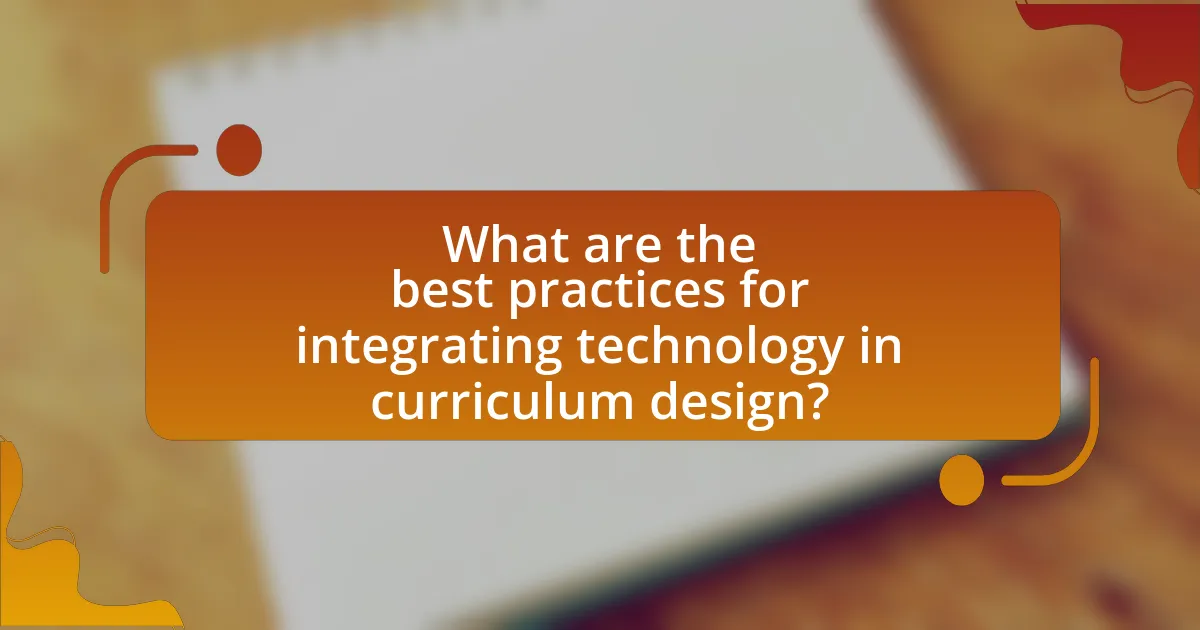
What are the best practices for integrating technology in curriculum design?
The best practices for integrating technology in curriculum design include aligning technology use with learning objectives, ensuring accessibility for all students, and providing professional development for educators. Aligning technology with learning objectives ensures that tools enhance educational outcomes rather than distract from them. Accessibility is crucial, as it allows all students, including those with disabilities, to benefit from technological resources. Professional development equips educators with the skills needed to effectively implement technology in their teaching, which has been shown to improve student engagement and learning outcomes. Research indicates that schools that prioritize these practices see a significant increase in student performance and satisfaction.
How can education associations effectively implement technology in their curricula?
Education associations can effectively implement technology in their curricula by adopting a structured approach that includes professional development for educators, integrating digital tools that enhance learning, and continuously evaluating the effectiveness of these technologies. Professional development ensures that educators are equipped with the necessary skills to utilize technology effectively, as studies show that teacher training significantly impacts technology integration success. For instance, the International Society for Technology in Education (ISTE) emphasizes the importance of ongoing training to help educators adapt to new tools. Additionally, integrating digital tools such as learning management systems, interactive software, and online resources can facilitate personalized learning experiences, which research indicates can improve student engagement and outcomes. Continuous evaluation through feedback and assessment metrics allows education associations to refine their technology use, ensuring that it meets the evolving needs of students and educators.
What steps should be taken to assess technology needs in curriculum design?
To assess technology needs in curriculum design, the first step is to conduct a comprehensive needs analysis that identifies the specific educational goals and challenges faced by educators and students. This analysis should involve gathering input from stakeholders, including teachers, students, and administrators, to understand their current technology usage and gaps.
Next, evaluate existing technology resources and infrastructure to determine their effectiveness in supporting curriculum objectives. This evaluation can include assessing hardware, software, and internet access, as well as the training needs of educators in using these technologies effectively.
Following the evaluation, prioritize technology needs based on the data collected, aligning them with curriculum goals and pedagogical strategies. This prioritization ensures that the most critical technology requirements are addressed first.
Finally, develop a strategic plan that outlines the implementation of the identified technology solutions, including timelines, budget considerations, and professional development opportunities for educators. This structured approach ensures that technology integration is purposeful and enhances the overall educational experience.
How can training and support be provided to educators for technology integration?
Training and support for educators in technology integration can be provided through structured professional development programs that focus on hands-on experience with the technology. These programs should include workshops, webinars, and collaborative learning communities that allow educators to practice using technology in real classroom scenarios. Research indicates that ongoing support, such as coaching and mentoring, significantly enhances educators’ confidence and competence in technology use (Graham et al., 2019, Journal of Educational Technology). Additionally, providing access to resources, such as instructional guides and online forums, can further assist educators in effectively integrating technology into their curriculum.
What role does collaboration play in successful technology integration?
Collaboration is essential for successful technology integration as it fosters shared knowledge, diverse perspectives, and collective problem-solving among educators and stakeholders. When educators collaborate, they can effectively identify the specific technological needs of their curriculum, ensuring that the tools selected align with educational goals. Research indicates that collaborative efforts lead to higher levels of engagement and innovation in technology use, as seen in studies like the one conducted by the International Society for Technology in Education, which found that schools with strong collaborative cultures reported more effective technology integration. This collaborative approach not only enhances the implementation process but also promotes ongoing support and professional development, ultimately leading to improved student outcomes.
How can education associations foster collaboration among educators and technology experts?
Education associations can foster collaboration among educators and technology experts by creating structured networking opportunities and professional development programs. These associations can organize workshops, conferences, and webinars that bring together educators and technology professionals to share best practices, tools, and strategies for integrating technology into the curriculum. For instance, the International Society for Technology in Education (ISTE) hosts an annual conference that facilitates collaboration through sessions and collaborative projects, demonstrating the effectiveness of such initiatives in enhancing educational practices.
What partnerships can enhance technology integration in curriculum design?
Collaborations between educational institutions and technology companies can significantly enhance technology integration in curriculum design. These partnerships enable access to cutting-edge tools and resources, fostering innovative teaching methods. For instance, partnerships with companies like Google or Microsoft provide educators with platforms such as Google Classroom or Microsoft Teams, which facilitate collaborative learning and resource sharing. Additionally, alliances with educational nonprofits, such as the International Society for Technology in Education (ISTE), offer professional development and best practices for integrating technology effectively. Research indicates that schools engaged in such partnerships report improved student engagement and learning outcomes, demonstrating the effectiveness of these collaborations in enhancing curriculum design.
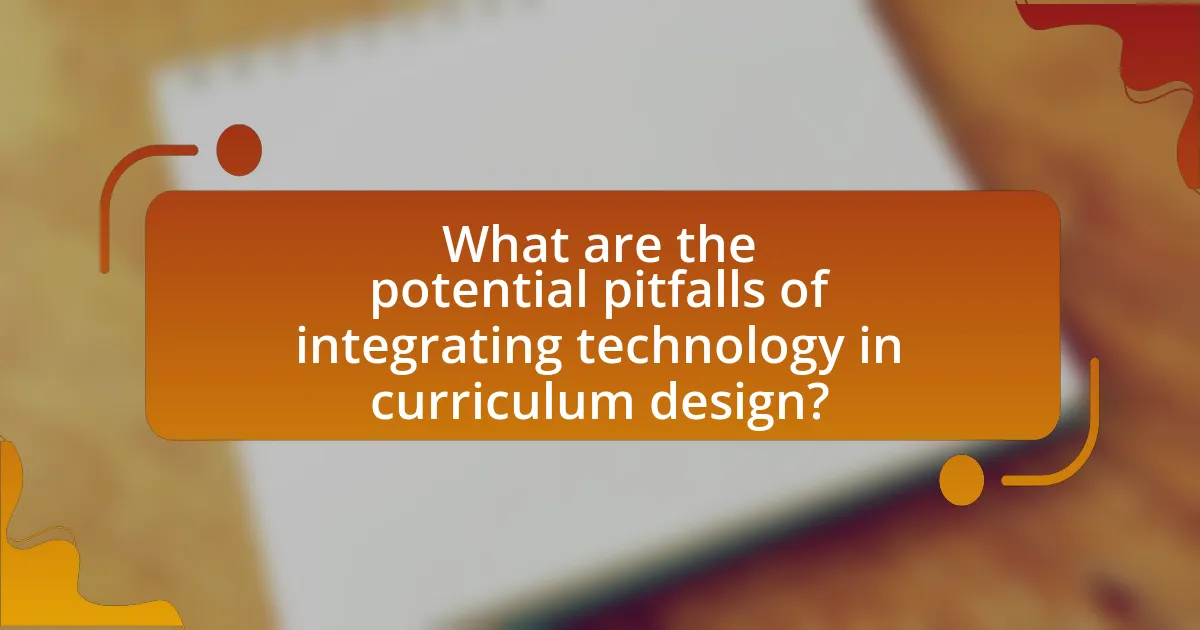
What are the potential pitfalls of integrating technology in curriculum design?
The potential pitfalls of integrating technology in curriculum design include inadequate training for educators, over-reliance on technology, and issues with accessibility. Inadequate training can lead to ineffective use of technology, as teachers may not fully understand how to incorporate digital tools into their teaching practices. Over-reliance on technology can diminish critical thinking and problem-solving skills among students, as they may depend too heavily on digital resources rather than engaging in traditional learning methods. Additionally, accessibility issues can arise if not all students have equal access to technology, potentially widening the achievement gap. According to a report by the National Center for Education Statistics, approximately 14% of students in the U.S. lack access to the internet at home, highlighting the importance of addressing these pitfalls to ensure equitable learning opportunities.
What common mistakes should education associations avoid?
Education associations should avoid the mistake of neglecting stakeholder engagement when integrating technology into curriculum design. Engaging teachers, students, and parents in the decision-making process ensures that the technology meets the actual needs of users, leading to more effective implementation. Research indicates that initiatives lacking stakeholder input often face resistance and fail to achieve desired outcomes, as seen in a study by the International Society for Technology in Education, which found that 70% of technology initiatives falter due to insufficient user involvement. Additionally, education associations should avoid underestimating the importance of professional development for educators, as inadequate training can lead to ineffective use of technology in the classroom.
How can resistance to change be managed during technology integration?
Resistance to change during technology integration can be managed through effective communication, stakeholder involvement, and training. Clear communication about the benefits and necessity of the technology fosters understanding and reduces fear. Involving stakeholders, including teachers and students, in the decision-making process ensures their concerns are addressed, increasing buy-in. Comprehensive training equips users with the skills needed to adapt to new technologies, thereby minimizing resistance. Research indicates that organizations that prioritize these strategies experience smoother transitions; for example, a study by Kotter (1996) highlights that successful change initiatives involve engaging employees and providing adequate support.
What are the risks of over-reliance on technology in education?
Over-reliance on technology in education can lead to diminished critical thinking skills among students. When students depend heavily on technology for information and problem-solving, they may not develop the ability to analyze, evaluate, and synthesize information independently. Research from the National Education Association indicates that excessive screen time can negatively impact cognitive development and reduce face-to-face social interactions, which are crucial for developing interpersonal skills. Additionally, over-reliance on technology can exacerbate educational inequalities, as not all students have equal access to technological resources, leading to a widening achievement gap.
How can education associations measure the success of technology integration?
Education associations can measure the success of technology integration by evaluating student engagement, academic performance, and teacher feedback. These metrics provide concrete indicators of how effectively technology enhances learning experiences. For instance, a study by the International Society for Technology in Education (ISTE) found that schools implementing technology integration saw a 20% increase in student engagement and a 15% improvement in standardized test scores. Additionally, collecting qualitative data through surveys and interviews with educators can reveal insights into the perceived effectiveness of technology tools in the classroom. This combination of quantitative and qualitative measures allows education associations to assess the impact of technology on educational outcomes comprehensively.
What metrics should be used to evaluate the effectiveness of technology in curriculum design?
To evaluate the effectiveness of technology in curriculum design, key metrics include student engagement, learning outcomes, and user satisfaction. Student engagement can be measured through participation rates in technology-enhanced activities, which often correlate with improved learning experiences. Learning outcomes are assessed by analyzing test scores and competency assessments before and after the integration of technology, demonstrating its impact on knowledge retention and skill acquisition. User satisfaction is gauged through surveys and feedback from both students and educators, providing insights into the usability and perceived value of the technology implemented. These metrics collectively offer a comprehensive view of how technology influences curriculum effectiveness.
How can feedback from educators and students inform future technology integration efforts?
Feedback from educators and students can significantly inform future technology integration efforts by providing insights into the effectiveness and usability of the technology in educational settings. Educators can share their experiences regarding how technology enhances or hinders teaching practices, while students can express their engagement levels and learning outcomes associated with the technology used. For instance, a study by the Bill & Melinda Gates Foundation found that when educators and students provided feedback on digital tools, it led to improved instructional strategies and better alignment of technology with learning objectives. This feedback loop allows for iterative improvements, ensuring that technology integration is responsive to the actual needs and challenges faced in the classroom.
What are practical tips for successful technology integration in curriculum design?
Successful technology integration in curriculum design involves aligning technology use with educational goals and enhancing student engagement. To achieve this, educators should first assess the specific needs of their students and the curriculum objectives, ensuring that technology serves a clear educational purpose. Additionally, providing professional development for teachers is crucial, as it equips them with the skills to effectively utilize technology in their teaching practices.
Moreover, incorporating student feedback can guide the selection of tools that resonate with learners, fostering a more interactive learning environment. Research indicates that when technology is integrated thoughtfully, it can lead to improved learning outcomes, as evidenced by a study from the International Society for Technology in Education, which found that effective technology use can enhance critical thinking and collaboration skills among students.
Finally, continuous evaluation and adaptation of technology tools are essential to ensure they remain relevant and effective in meeting educational goals.
